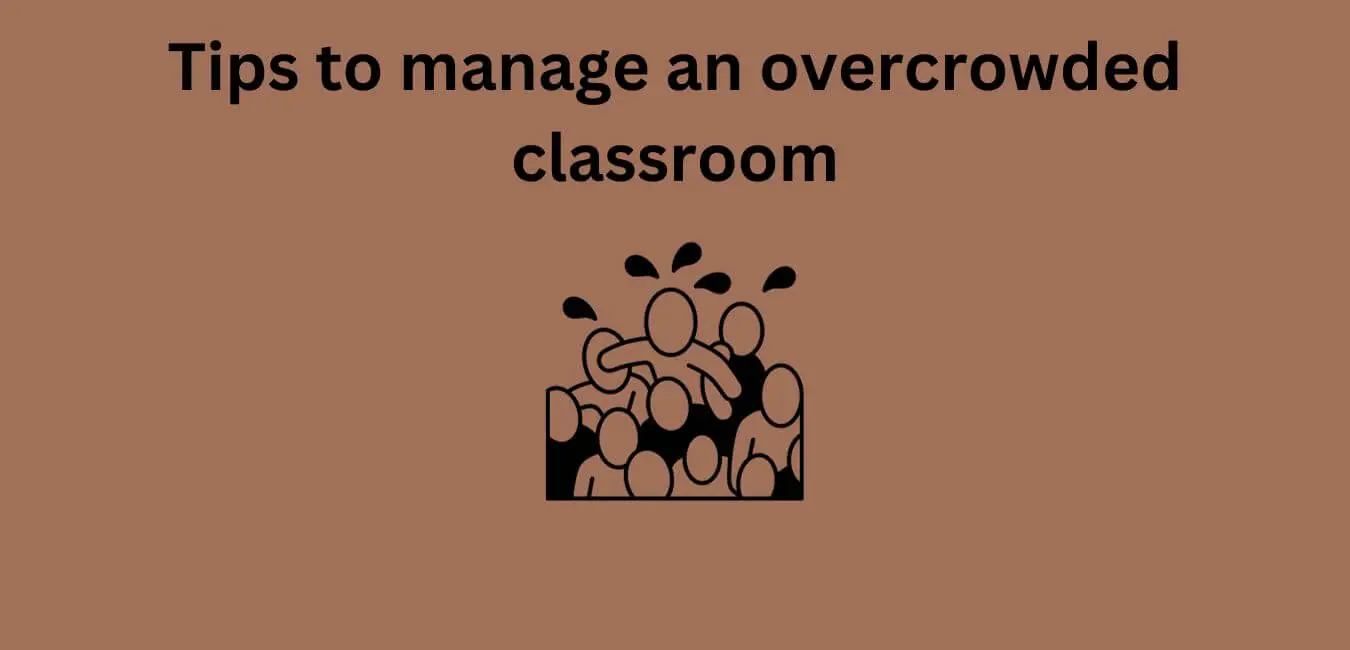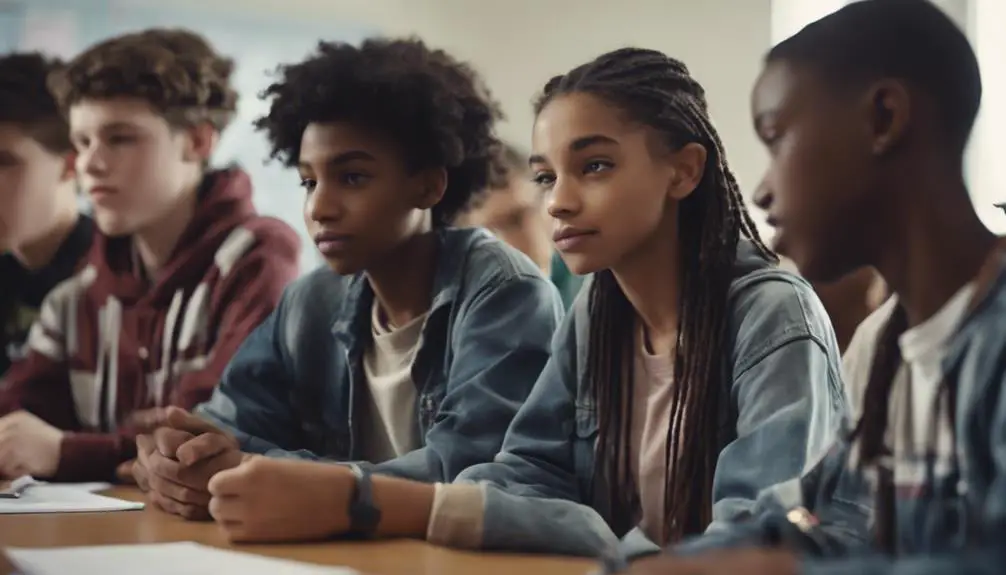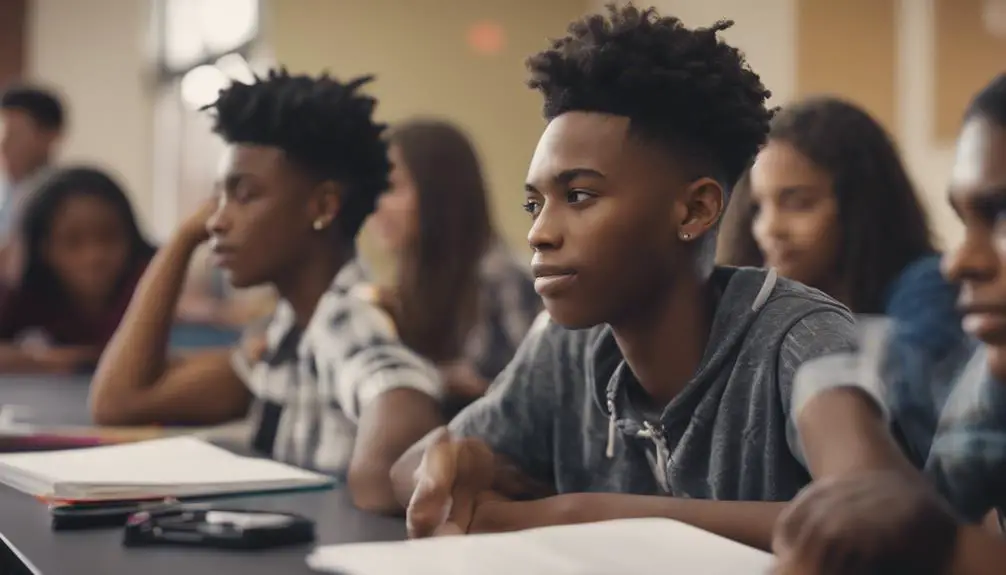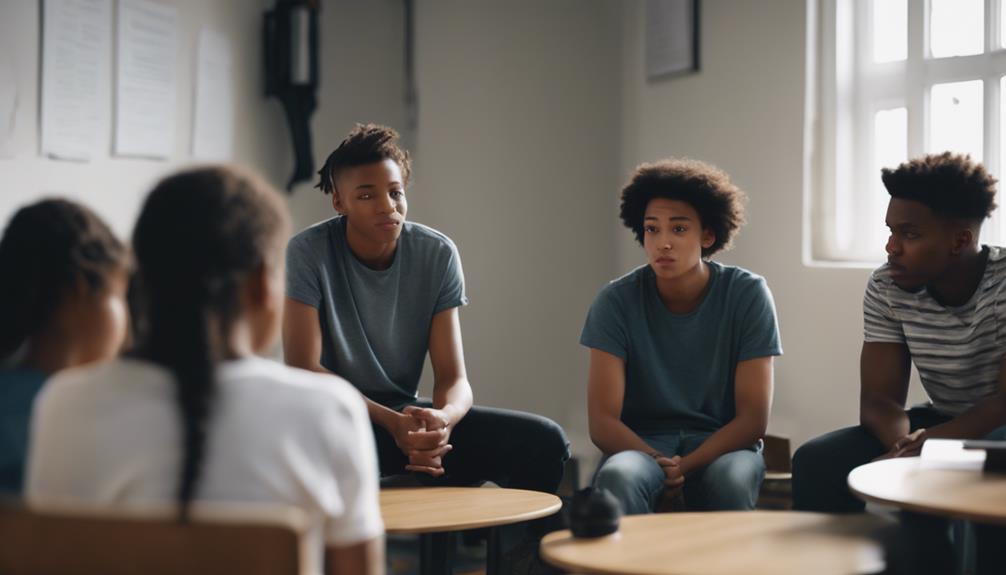
Even for the most experienced educators, walking into an overcrowded classroom can feel like stepping onto a daunting stage. Believe me, I’ve walked in those shoes and research shows that I’m far from alone.
This is a widespread challenge impacting teachers across the globe. In this article, we’ll unveil 21 effective strategies to successfully manage your lively class while addressing 11 important factors often found in such environments.
Curious? Let’s journey together through the realm of proven teaching techniques!
Key Takeaways
- Keep everyone busy by having tasks for each student to do, like activities or reading.
- Use flexible grouping to create smaller groups and give students individualized attention.
- Keep lessons short to prevent overwhelming students and allow for more individualized instruction.
- Plan ahead to anticipate challenges and be prepared with resources and clear expectations.
- Establish clear expectations and routines to create a structured learning environment.
- Use technology to engage students and make learning interactive.
- Consider the layout and organization of your classroom to optimize space.
- Use behavior management strategies, such as clear rules, positive reinforcement, and engaging activities.
- Find ways to provide individualized attention through differentiation, assistive technology, and collaboration with support staff.
Tips for Managing an Overcrowded Classroom
Keep everyone busy by incorporating hands-on activities and group work to ensure all students are actively engaged in the learning process.
Keep everyone busy
Classrooms can get chaotic with too many kids. The secret is to keep them all busy. This way, they won’t distract each other or disrupt the class. Make sure every child has a task at hand.
They could be working on an activity, reading a book, or writing in their notebook. It’s all about having control and organizing tasks for everyone to do something productive and learning-based at the same time!
Use flexible grouping
In an overcrowded classroom, using flexible grouping can be a helpful strategy. This means organizing students into different groups based on their abilities or learning needs. By doing this, you can create smaller groups where students can work together and receive more individualized attention.
For example, you can group high-achieving students together for challenging tasks, while providing extra support to struggling learners in smaller groups. It allows you to tailor your teaching approach to meet the diverse needs of your students.
Flexible grouping also encourages collaboration and peer learning, which can enhance student engagement and promote a positive learning environment.
By using flexible grouping techniques in an overcrowded classroom, you’re able to address the unique needs of each student more effectively. It helps optimize instructional time by allowing you to provide targeted support where it’s most needed without neglecting other students.
Keep lessons short
To manage an overcrowded classroom, it’s important to keep lessons short. This allows you to cover the necessary material without overwhelming your students or losing their attention.
Shorter lessons also give you more time for individualized instruction and addressing questions or concerns from your students. By keeping lessons concise and focused, you can make sure that all students have a chance to participate and engage in the learning process.
Plan ahead
Planning ahead is essential when managing an overcrowded classroom. By being proactive and prepared, you can anticipate potential challenges and find solutions in advance. This involves carefully designing your lessons and activities to accommodate a larger number of students, ensuring that everyone has the opportunity to participate and engage.
Additionally, planning ahead allows you to establish clear expectations and routines from the start, helping to create a structured learning environment that minimizes distractions.
When you plan ahead, you can also identify any necessary resources or materials that may be needed for specific lessons or projects, ensuring smooth implementation without disruptions.
Establish clear expectations and routines
Establishing clear expectations and routines is essential in managing an overcrowded classroom. It helps create a structured learning environment and ensures that students understand what is expected of them. Here are some ways to establish clear expectations and routines:
- Communicate the rules: Clearly communicate the classroom rules to students at the beginning of the school year or when new students join the class. Use simple language and visuals if needed.
- Reinforce positive behavior: Recognize and praise students who follow the rules and exhibit positive behavior. This reinforces good habits and encourages others to do the same.
- Consistent consequences: Establish consistent consequences for breaking the rules or not following expectations. Make sure that these consequences are fair and age-appropriate.
- Set a routine: Create a daily routine that includes regular times for different activities, such as starting class, transitions between subjects, breaks, and dismissal. Stick to this routine as much as possible to help students feel secure and know what to expect.
- Teach procedures: Take time to explicitly teach procedures for common classroom tasks, such as entering/exiting the classroom, getting materials, turning in assignments, etc. Practice these procedures until they become second nature for students.
- Use visual cues: Use visual cues like posters or charts to help remind students of expectations or steps for specific tasks. These visual reminders can be especially helpful for younger or struggling learners.
- Model expected behavior: Be a role model by consistently demonstrating the behaviors you expect from your students. Show them how to listen attentively, engage in discussions respectfully, ask questions, etc.
- Involve students in creating expectations: Give students a voice by involving them in creating classroom expectations together with you. This helps them take ownership of their behavior and fosters a sense of responsibility.
- Review regularly: Regularly review the expectations and routines with your students throughout the year to ensure they remember them and continue to follow them.
- Provide reminders: Give verbal or visual reminders when necessary to redirect students back to the established expectations and routines.
- Seek input and feedback: Allow students to provide input or feedback on the rules and routines. This creates a collaborative classroom environment where everyone’s opinions and thoughts are valued.
Use technology to facilitate learning
In today’s overcrowded classrooms, technology can be a helpful tool to facilitate learning. By incorporating technology into lessons, teachers can engage students and make the material more interactive and accessible.
For example, using educational apps or online resources allows students to explore topics at their own pace and in different ways. This helps cater to individual learning styles and interests.
Additionally, technology can help manage the classroom by providing digital tools for organization, communication, and assessment. Teachers can use digital platforms to distribute assignments, communicate with students and parents, track progress, and provide feedback.
Factors to Consider When Managing an Overcrowded Classroom
Consider the layout and organization of your classroom to optimize space and minimize distractions.
Classroom layout and organization
In an overcrowded classroom, it’s important to have a well-organized layout. This can help maximize the space and make it easier for students to move around. Consider arranging desks in rows or clusters, leaving enough space for students to walk between them.
In terms of organization, clearly label materials and supplies so that students can easily find what they need. Use visual aids such as charts and posters to create clear learning zones and display important information.
By having a well-organized layout, you can create a more efficient and productive learning environment for your students.
Behavior management strategies
Managing behavior in an overcrowded classroom can be challenging, but with effective strategies, it is possible to create a positive learning environment. Here are some tips to help manage behavior:
- Establish clear expectations: Clearly communicate your classroom rules and consequences to students.
- Consistent reinforcement: Be consistent in enforcing the rules and consequences to maintain a structured environment.
- Positive reinforcement: Recognize and reward positive behavior to encourage students to make good choices.
- Use engaging activities: Incorporate hands-on and interactive activities to keep students engaged and focused on their learning.
- Individual attention: Find opportunities to provide individual attention to each student, even in a crowded classroom, by checking in with them during independent work or small group discussions.
- Classroom routines: Establish predictable routines for transitions, materials distribution, and other daily tasks to minimize disruptions.
- Engage parents/guardians: Communicate regularly with parents/guardians about their child’s behavior and seek their support in reinforcing expectations at home.
- Peer support: Encourage students to support each other by promoting a positive classroom culture where they celebrate each other’s achievements.
- Behavior charts/rewards system: Implement a visual behavior chart or rewards system where students can track their progress and receive incentives for meeting behavioral goals.
- Redirecting behavior: Quickly address off-task or disruptive behaviors by redirecting the student’s attention back to the task at hand without drawing unnecessary attention.
- Collaborate with colleagues: Share ideas and strategies with fellow teachers who may have experience managing large classes, as they may have valuable insights or resources to offer.
Individualized attention
In an overcrowded classroom, it can be challenging to give each student the attention they need. However, finding ways to provide individualized attention is important for their learning and growth.
One way to do this is through differentiation and personalized instruction. By assessing students’ abilities and tailoring lessons to meet their needs, you can help them succeed. Utilizing assistive technology and resources can also support individualized attention by providing extra assistance or accommodations for students with special needs.
Collaborating with specialized support staff, such as counselors or speech therapists, can further address the unique needs of students in an overcrowded classroom. Remember that every student deserves a chance to shine, so finding ways to give them individualized attention is crucial in managing an overcrowded classroom successfully.
Building positive relationships
Building positive relationships is a crucial aspect of managing an overcrowded classroom. When there are many students in a class, it can be challenging to establish connections with each one individually.
However, taking the time to get to know your students personally can make a big difference in how they engage and behave in class.
One way to build positive relationships is by showing genuine interest in your students’ lives and experiences. Take the time to listen to their stories, ask about their interests, and acknowledge their achievements.
This helps them feel valued and recognized as individuals.
Additionally, creating a supportive and inclusive learning environment promotes positive relationships among students themselves. Encourage teamwork, collaboration, and mutual respect among classmates.
Provide opportunities for group work or partner activities that allow them to interact and learn from each other.
Collaboration with colleagues
Working together with colleagues is essential when managing an overcrowded classroom. Sharing strategies and ideas can help alleviate some of the challenges that come with a crowded learning environment.
By collaborating, teachers can brainstorm effective behavior management techniques, discuss lesson plans that engage students, and explore different ways to create a positive learning environment.
Collaborating with colleagues also provides support and encouragement, as they understand the unique circumstances of managing an overcrowded classroom. Together, teachers can find solutions and make a difference in the lives of their students.
Seeking support from the administration
It is important to seek support from your school administration when managing an overcrowded classroom. They can provide guidance and resources to help address the challenges you may face.
By collaborating with administrators, you can advocate for smaller class sizes or additional support staff. They may also be able to assist in finding creative solutions, such as rearranging classrooms or utilizing available space more effectively.
Additionally, administrators can play a crucial role in implementing behavior management strategies and supporting teachers in maintaining a positive learning environment. Building a strong relationship with your administration can make a significant difference in managing an overcrowded classroom successfully.
Strategies for Engaging Students in an Overcrowded Classroom
Incorporate hands-on activities, group work, and differentiated instruction to keep students engaged and motivated in an overcrowded classroom. Discover how these strategies can make a positive impact on student learning!
Utilize hands-on activities
In an overcrowded classroom, it can be challenging to keep students engaged. One effective strategy is to utilize hands-on activities. These activities allow students to actively participate in their learning and interact with the materials.
For example, instead of just reading about a scientific concept, students can conduct experiments or create models to explore it firsthand. This not only helps them understand the content better but also keeps them focused and excited about learning.
Hands-on activities also promote collaboration and critical thinking skills as students work together and problem-solve during the activity. By incorporating these types of engaging activities into your lessons, you can help manage an overcrowded classroom more effectively and create a positive learning environment for your students.
Incorporate group work and cooperative learning
Group work and cooperative learning are effective strategies to engage students in an overcrowded classroom. Here are some ideas to incorporate these techniques:
- Divide students into small groups to encourage collaboration and teamwork.
- Assign group projects or activities that require students to work together to solve problems or complete tasks.
- Provide clear guidelines and expectations for group work, including roles and responsibilities for each team member.
- Use structured protocols or procedures to ensure equal participation from all group members.
- Facilitate discussions and encourage students to share their ideas and perspectives with their peers.
- Monitor group dynamics and intervene if necessary to ensure everyone is included and respected.
- Incorporate opportunities for peer feedback and reflection on group work outcomes.
- Celebrate the achievements of each group to foster a positive learning environment.
Provide choice and autonomy
In an overcrowded classroom, it’s important to give students choices and autonomy in their learning. This can help them feel more engaged and motivated. For example, you can let students choose the topic for a project or allow them to decide how they want to demonstrate their understanding of a lesson.
By giving students options, you are empowering them to take ownership of their education and encouraging their active participation in the classroom. Providing choice and autonomy also helps address the diverse needs and interests of your students, making learning more personalized and meaningful for each individual.
Use differentiated instruction
In a crowded classroom, it’s important to use differentiated instruction. This means tailoring your teaching to meet the needs of each student. Some students may learn best through hands-on activities, while others may prefer working in groups.
By offering different options and approaches, you can engage all students and help them succeed. Providing individualized support is crucial in managing an overcrowded classroom. Remember that every student is unique and may require different strategies or resources to fully understand the material.
Incorporate movement and kinesthetic learning
To keep students engaged in an overcrowded classroom, incorporating movement and kinesthetic learning can be helpful. Instead of sitting still for long periods, allow students to get up and move around during lessons.
This can involve activities like group work, interactive games, or even simple stretching exercises. By incorporating movement into the learning process, students are more likely to stay focused and retain information better.
Additionally, kinesthetic learning involves hands-on activities that allow students to physically interact with the lesson material. It could include experiments, role-playing scenarios, or building projects.
These types of activities cater to different learning styles and make lessons more enjoyable for students in an overcrowded classroom situation.
Addressing the Needs of Diverse Learners in an Overcrowded Classroom
In an overcrowded classroom, it’s crucial to address the needs of diverse learners. Differentiation and individualized instruction can help meet each student’s unique learning style and abilities.
Utilizing assistive technology and resources can also provide additional support for students with special needs. Additionally, collaborating with specialized support staff can ensure that all students receive the necessary assistance they require.
Discover effective strategies to support diverse learners in an overcrowded classroom – read more!
Differentiation and individualized instruction
In an overcrowded classroom, it can be challenging to provide each student with the individual attention they need. However, differentiation and individualized instruction can help address this issue.
By tailoring lessons and assignments to meet the specific needs of each student, teachers can ensure that everyone is engaged and learning at their own pace. This may involve providing additional resources or materials for students who need extra support or offering more advanced tasks for those who are ready for a challenge.
By personalizing instruction in this way, teachers can better meet the diverse learning needs of their students in an overcrowded classroom setting.
Utilizing assistive technology and resources
In an overcrowded classroom, utilizing assistive technology and resources can greatly benefit both teachers and students. Assistive technology refers to tools or devices that help individuals with disabilities perform tasks more easily.
In the context of a crowded classroom, this can include things like audio-visual aids, digital resources, and interactive learning platforms. These tools can make it easier for teachers to engage all students and provide individualized instruction.
For example, using educational apps or software can allow students to work at their own pace and access additional support when needed. Additionally, assistive technology can also help students with special needs learners participate more fully in class activities.
Providing support for learners
In an overcrowded classroom, providing support for learners is crucial. These students may face additional challenges in understanding and participating in lessons due to their limited proficiency in English.
Teachers can help by using visual aids, gestures, and simplified language to make instructions more accessible. They can also provide extra resources such as bilingual dictionaries or translated materials.
Collaborating with specialized support staff, like English as a Second Language (ESL) teachers or speech therapists, can further assist these learners in their language development.
Collaborating with specialized support staff
Collaborating with specialized support staff is important when managing an overcrowded classroom. These professionals, such as special education teachers or speech therapists, can provide valuable assistance and resources to meet the diverse needs of students.
By working together, we can develop individualized strategies for student success and ensure that every student has access to the support they require. This collaboration helps create a positive learning environment where all students feel valued and supported.
Together, we can make a difference in our overcrowded classrooms by utilizing the expertise of specialized support staff.
FAQs
1. What are some tips for managing an overcrowded classroom?
Here are some tips: Use effective classroom management skills, plan your lessons well, lessen distractions, boost learning promotion actions, and get ready for each lesson ahead of time.
2. How can a teacher handle the problems in an overcrowded classroom?
Teachers can use strategies such as knowing their students’ interests and promoting engagement in lessons, seeking support from their peers or the school administration when needed, and setting rules for discipline.
3. Who else apart from teachers can help deal with crowded classrooms?
Not only teachers but also secondary school administrators have a role to play. They must give leadership guidance to ensure students learn even in overpopulated schools.
4. Can research design help in managing an overcrowded classroom?
Yes! Teacher experiences and research designs about past crowded classes could be used by others to solve similar problems later on.
5. How important is organization while dealing with an overloaded class?
Very important! Classroom organization helps avoid chaos, and helps focus more on differentiated learning for students despite dealing with overpopulation issues.
Conclusion
Managing an overcrowded classroom can be challenging, but with the right strategies and considerations, teachers can create a positive learning environment. By keeping everyone busy, using flexible grouping, planning ahead, and establishing clear expectations, teachers can effectively manage their classrooms.
Factors like classroom organization, behavior management strategies, individualized attention, and collaboration with colleagues also play a crucial role in managing an overcrowded classroom.
By following these tips and considering these factors, teachers can ensure that students are engaged and supported in their learning journey.




















